MGT603: Systems Thinking Assignment - Proposal and Critique
VerifiedAdded on 2022/10/19
|7
|1332
|23
Homework Assignment
AI Summary
This assignment solution addresses a Systems Thinking assignment (MGT603) focusing on a healthcare scenario. Part A proposes a systems thinking approach to address service gaps, inappropriate health information systems, and insufficient financing at Noarlunga Public Hospital, particularly concerning Aboriginal healthcare. It utilizes the CATWOE framework to analyze the situation. Part B provides critiques of two peer submissions, evaluating their holistic approach, problem-solving strategies, and the effectiveness of their CATWOE application. The solution highlights the importance of holistic thinking, comprehensive problem analysis, and the use of frameworks like CATWOE in organizational contexts.
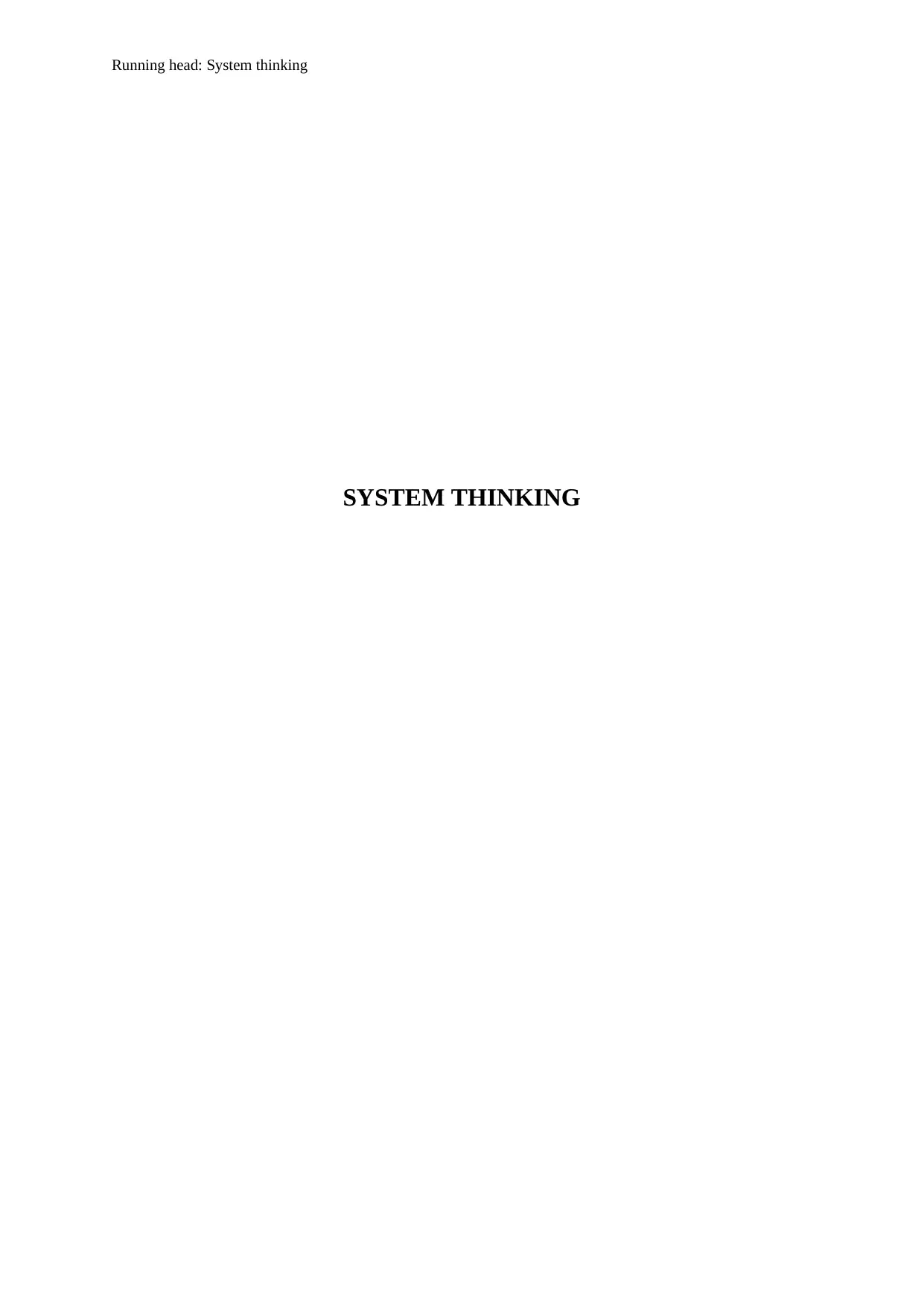
Running head: System thinking
SYSTEM THINKING
SYSTEM THINKING
Paraphrase This Document
Need a fresh take? Get an instant paraphrase of this document with our AI Paraphraser
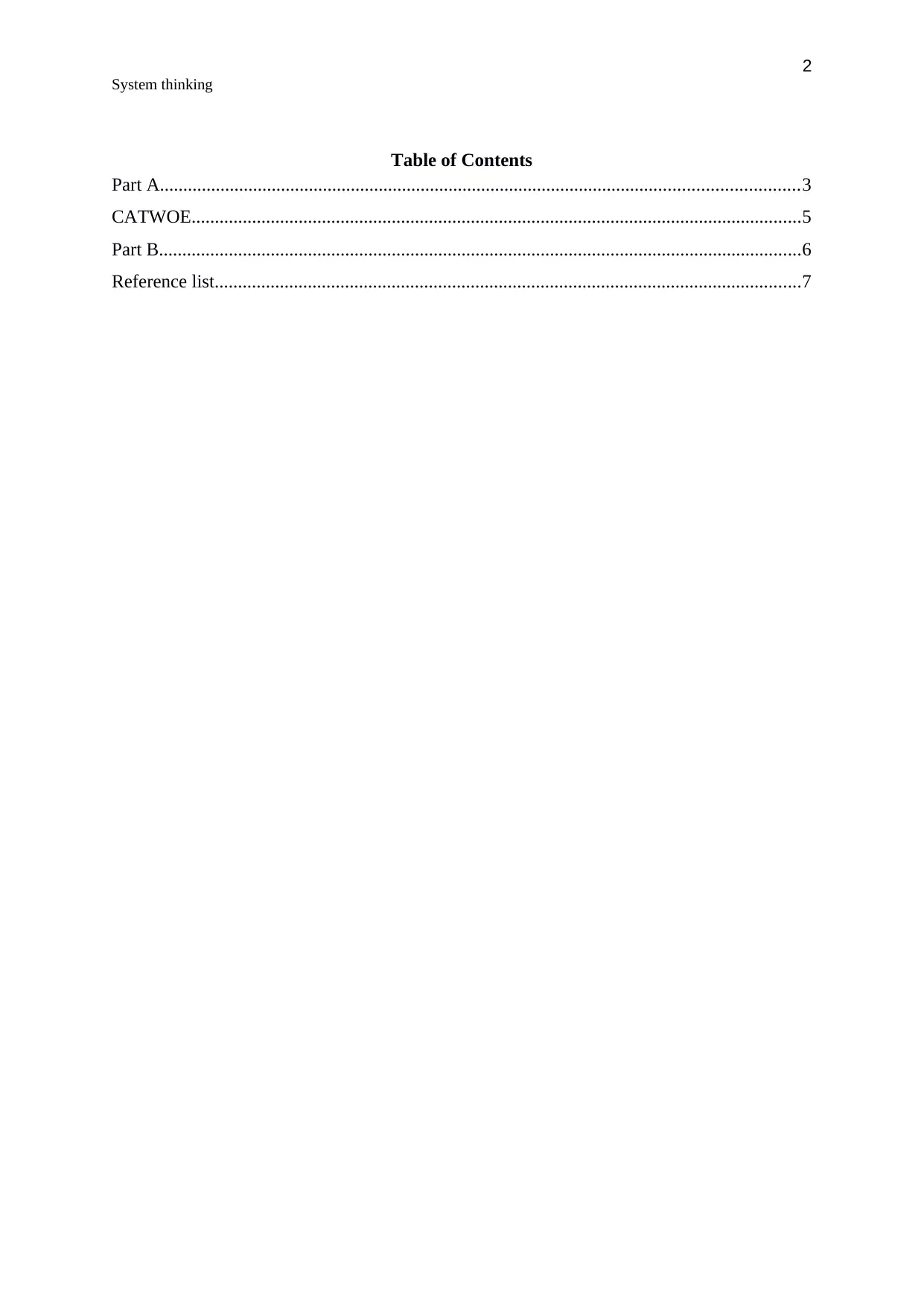
2
System thinking
Table of Contents
Part A.........................................................................................................................................3
CATWOE...................................................................................................................................5
Part B..........................................................................................................................................6
Reference list..............................................................................................................................7
System thinking
Table of Contents
Part A.........................................................................................................................................3
CATWOE...................................................................................................................................5
Part B..........................................................................................................................................6
Reference list..............................................................................................................................7
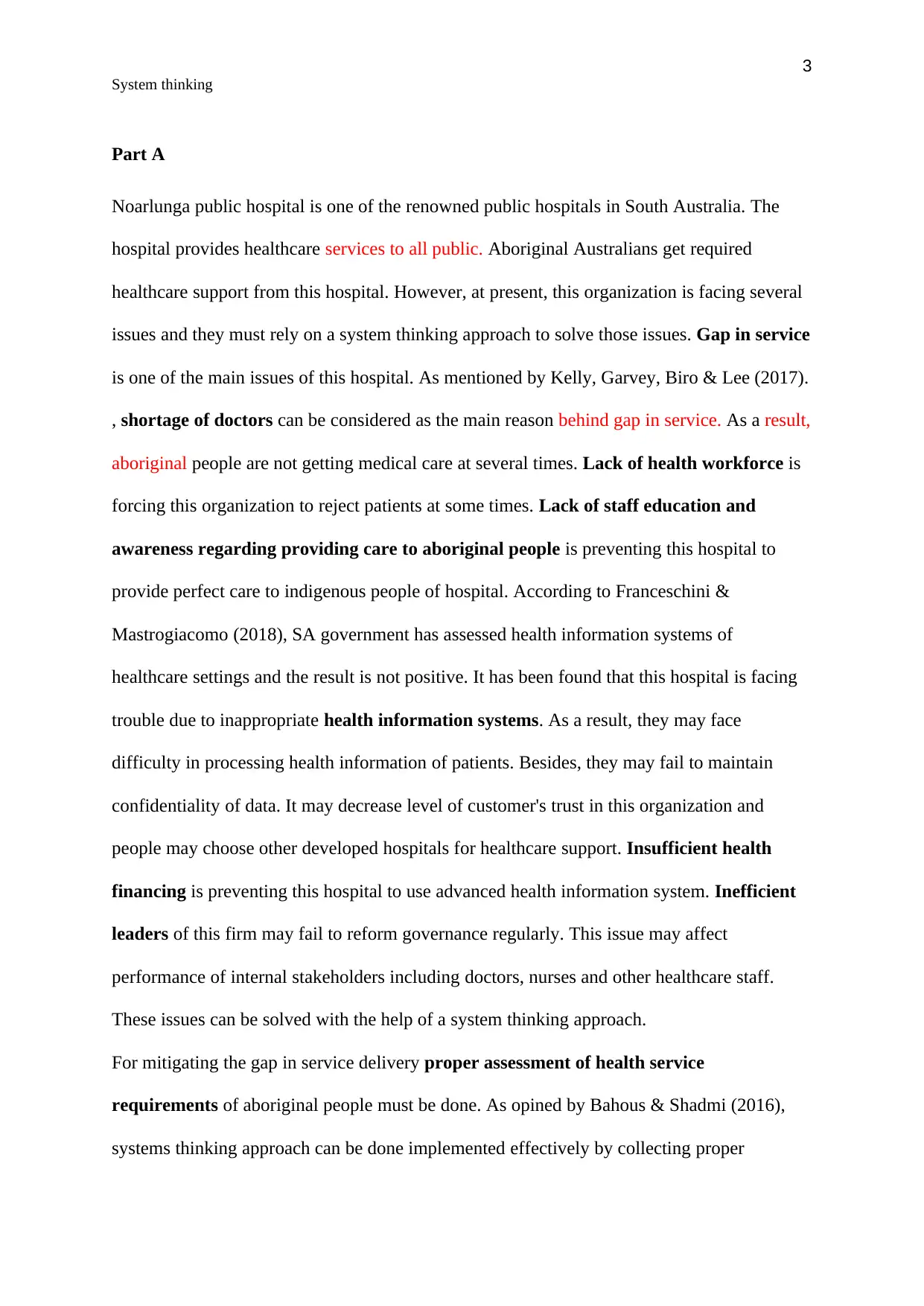
3
System thinking
Part A
Noarlunga public hospital is one of the renowned public hospitals in South Australia. The
hospital provides healthcare services to all public. Aboriginal Australians get required
healthcare support from this hospital. However, at present, this organization is facing several
issues and they must rely on a system thinking approach to solve those issues. Gap in service
is one of the main issues of this hospital. As mentioned by Kelly, Garvey, Biro & Lee (2017).
, shortage of doctors can be considered as the main reason behind gap in service. As a result,
aboriginal people are not getting medical care at several times. Lack of health workforce is
forcing this organization to reject patients at some times. Lack of staff education and
awareness regarding providing care to aboriginal people is preventing this hospital to
provide perfect care to indigenous people of hospital. According to Franceschini &
Mastrogiacomo (2018), SA government has assessed health information systems of
healthcare settings and the result is not positive. It has been found that this hospital is facing
trouble due to inappropriate health information systems. As a result, they may face
difficulty in processing health information of patients. Besides, they may fail to maintain
confidentiality of data. It may decrease level of customer's trust in this organization and
people may choose other developed hospitals for healthcare support. Insufficient health
financing is preventing this hospital to use advanced health information system. Inefficient
leaders of this firm may fail to reform governance regularly. This issue may affect
performance of internal stakeholders including doctors, nurses and other healthcare staff.
These issues can be solved with the help of a system thinking approach.
For mitigating the gap in service delivery proper assessment of health service
requirements of aboriginal people must be done. As opined by Bahous & Shadmi (2016),
systems thinking approach can be done implemented effectively by collecting proper
System thinking
Part A
Noarlunga public hospital is one of the renowned public hospitals in South Australia. The
hospital provides healthcare services to all public. Aboriginal Australians get required
healthcare support from this hospital. However, at present, this organization is facing several
issues and they must rely on a system thinking approach to solve those issues. Gap in service
is one of the main issues of this hospital. As mentioned by Kelly, Garvey, Biro & Lee (2017).
, shortage of doctors can be considered as the main reason behind gap in service. As a result,
aboriginal people are not getting medical care at several times. Lack of health workforce is
forcing this organization to reject patients at some times. Lack of staff education and
awareness regarding providing care to aboriginal people is preventing this hospital to
provide perfect care to indigenous people of hospital. According to Franceschini &
Mastrogiacomo (2018), SA government has assessed health information systems of
healthcare settings and the result is not positive. It has been found that this hospital is facing
trouble due to inappropriate health information systems. As a result, they may face
difficulty in processing health information of patients. Besides, they may fail to maintain
confidentiality of data. It may decrease level of customer's trust in this organization and
people may choose other developed hospitals for healthcare support. Insufficient health
financing is preventing this hospital to use advanced health information system. Inefficient
leaders of this firm may fail to reform governance regularly. This issue may affect
performance of internal stakeholders including doctors, nurses and other healthcare staff.
These issues can be solved with the help of a system thinking approach.
For mitigating the gap in service delivery proper assessment of health service
requirements of aboriginal people must be done. As opined by Bahous & Shadmi (2016),
systems thinking approach can be done implemented effectively by collecting proper
⊘ This is a preview!⊘
Do you want full access?
Subscribe today to unlock all pages.

Trusted by 1+ million students worldwide
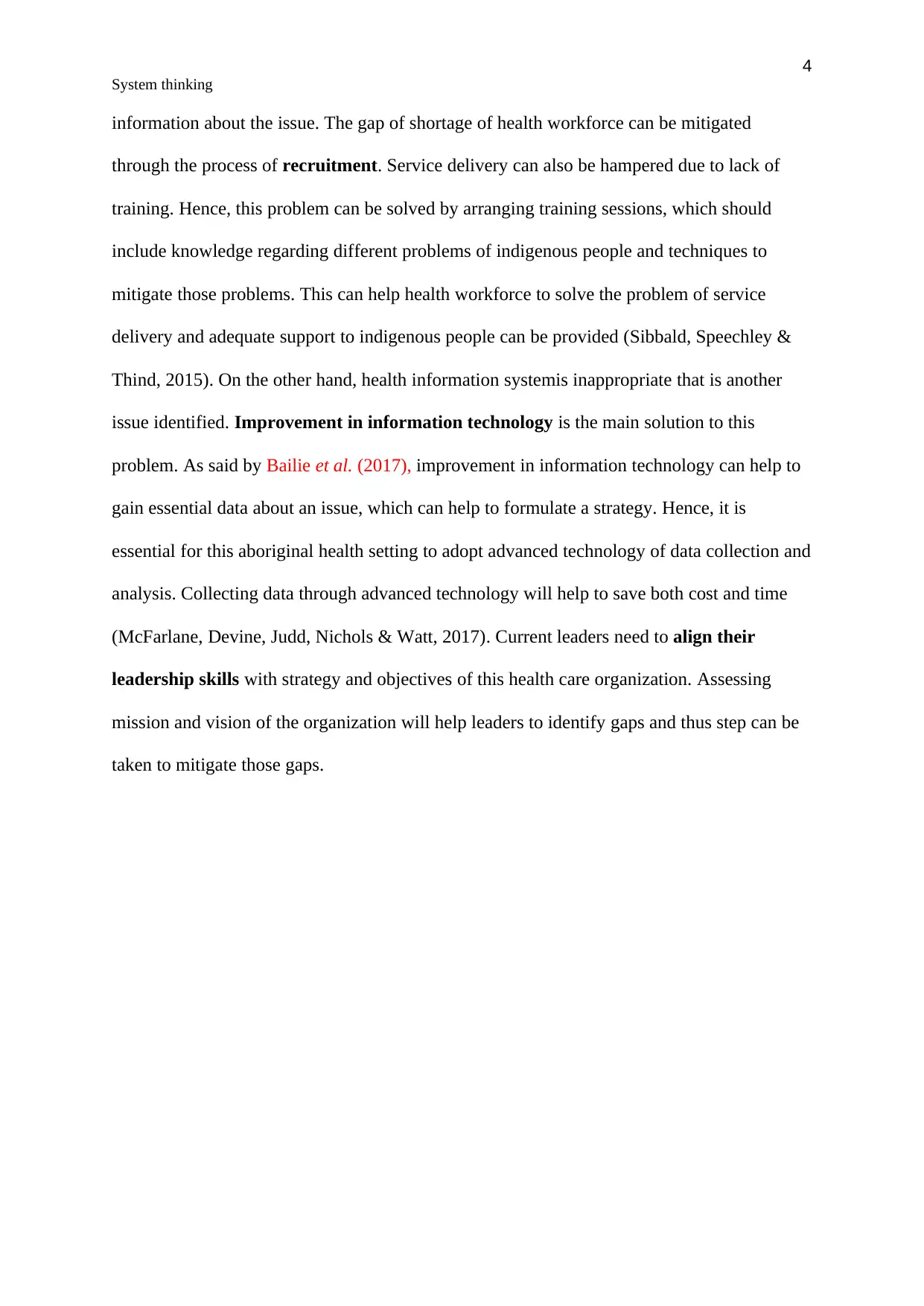
4
System thinking
information about the issue. The gap of shortage of health workforce can be mitigated
through the process of recruitment. Service delivery can also be hampered due to lack of
training. Hence, this problem can be solved by arranging training sessions, which should
include knowledge regarding different problems of indigenous people and techniques to
mitigate those problems. This can help health workforce to solve the problem of service
delivery and adequate support to indigenous people can be provided (Sibbald, Speechley &
Thind, 2015). On the other hand, health information systemis inappropriate that is another
issue identified. Improvement in information technology is the main solution to this
problem. As said by Bailie et al. (2017), improvement in information technology can help to
gain essential data about an issue, which can help to formulate a strategy. Hence, it is
essential for this aboriginal health setting to adopt advanced technology of data collection and
analysis. Collecting data through advanced technology will help to save both cost and time
(McFarlane, Devine, Judd, Nichols & Watt, 2017). Current leaders need to align their
leadership skills with strategy and objectives of this health care organization. Assessing
mission and vision of the organization will help leaders to identify gaps and thus step can be
taken to mitigate those gaps.
System thinking
information about the issue. The gap of shortage of health workforce can be mitigated
through the process of recruitment. Service delivery can also be hampered due to lack of
training. Hence, this problem can be solved by arranging training sessions, which should
include knowledge regarding different problems of indigenous people and techniques to
mitigate those problems. This can help health workforce to solve the problem of service
delivery and adequate support to indigenous people can be provided (Sibbald, Speechley &
Thind, 2015). On the other hand, health information systemis inappropriate that is another
issue identified. Improvement in information technology is the main solution to this
problem. As said by Bailie et al. (2017), improvement in information technology can help to
gain essential data about an issue, which can help to formulate a strategy. Hence, it is
essential for this aboriginal health setting to adopt advanced technology of data collection and
analysis. Collecting data through advanced technology will help to save both cost and time
(McFarlane, Devine, Judd, Nichols & Watt, 2017). Current leaders need to align their
leadership skills with strategy and objectives of this health care organization. Assessing
mission and vision of the organization will help leaders to identify gaps and thus step can be
taken to mitigate those gaps.
Paraphrase This Document
Need a fresh take? Get an instant paraphrase of this document with our AI Paraphraser
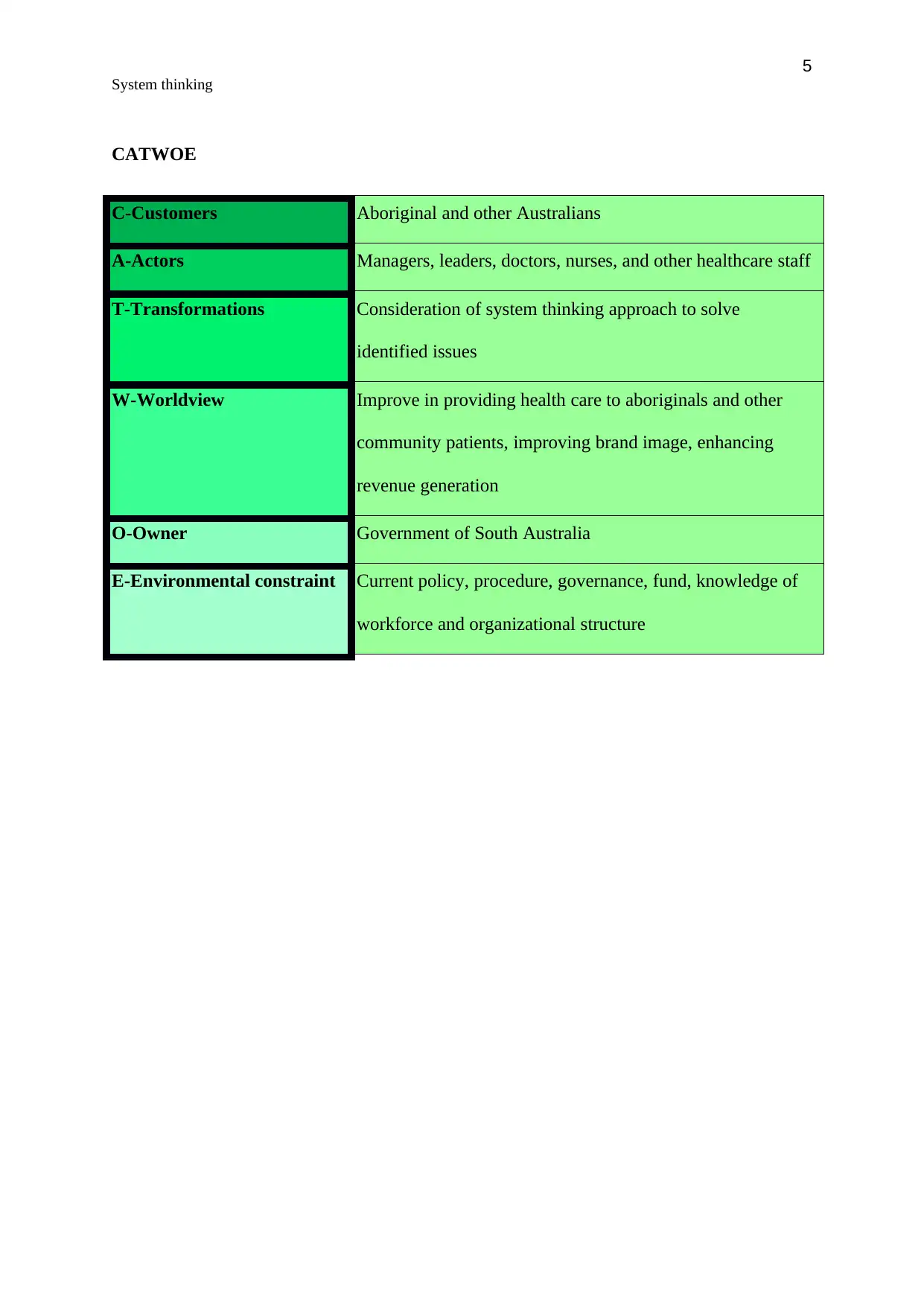
5
System thinking
CATWOE
C-Customers Aboriginal and other Australians
A-Actors Managers, leaders, doctors, nurses, and other healthcare staff
T-Transformations Consideration of system thinking approach to solve
identified issues
W-Worldview Improve in providing health care to aboriginals and other
community patients, improving brand image, enhancing
revenue generation
O-Owner Government of South Australia
E-Environmental constraint Current policy, procedure, governance, fund, knowledge of
workforce and organizational structure
System thinking
CATWOE
C-Customers Aboriginal and other Australians
A-Actors Managers, leaders, doctors, nurses, and other healthcare staff
T-Transformations Consideration of system thinking approach to solve
identified issues
W-Worldview Improve in providing health care to aboriginals and other
community patients, improving brand image, enhancing
revenue generation
O-Owner Government of South Australia
E-Environmental constraint Current policy, procedure, governance, fund, knowledge of
workforce and organizational structure
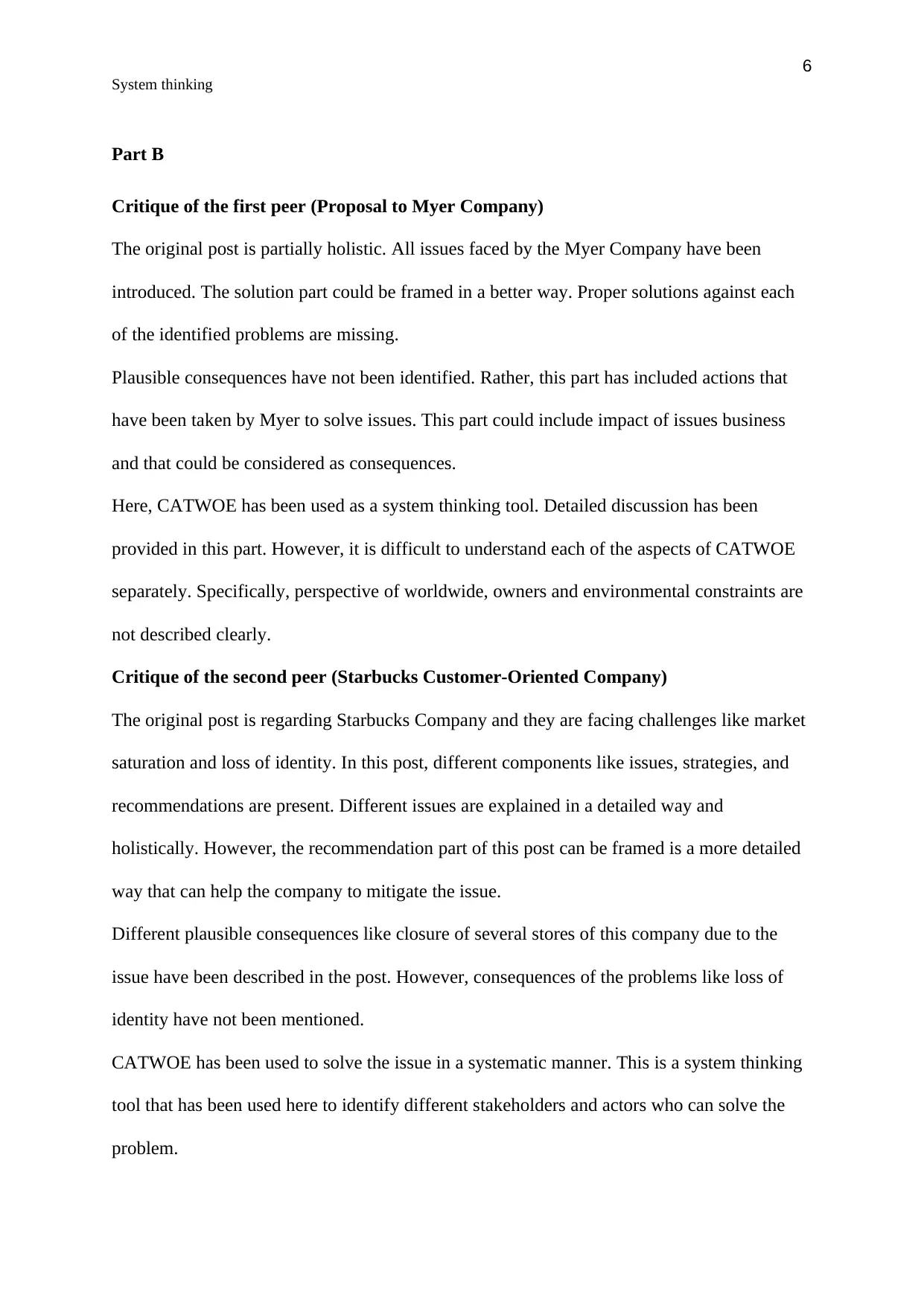
6
System thinking
Part B
Critique of the first peer (Proposal to Myer Company)
The original post is partially holistic. All issues faced by the Myer Company have been
introduced. The solution part could be framed in a better way. Proper solutions against each
of the identified problems are missing.
Plausible consequences have not been identified. Rather, this part has included actions that
have been taken by Myer to solve issues. This part could include impact of issues business
and that could be considered as consequences.
Here, CATWOE has been used as a system thinking tool. Detailed discussion has been
provided in this part. However, it is difficult to understand each of the aspects of CATWOE
separately. Specifically, perspective of worldwide, owners and environmental constraints are
not described clearly.
Critique of the second peer (Starbucks Customer-Oriented Company)
The original post is regarding Starbucks Company and they are facing challenges like market
saturation and loss of identity. In this post, different components like issues, strategies, and
recommendations are present. Different issues are explained in a detailed way and
holistically. However, the recommendation part of this post can be framed is a more detailed
way that can help the company to mitigate the issue.
Different plausible consequences like closure of several stores of this company due to the
issue have been described in the post. However, consequences of the problems like loss of
identity have not been mentioned.
CATWOE has been used to solve the issue in a systematic manner. This is a system thinking
tool that has been used here to identify different stakeholders and actors who can solve the
problem.
System thinking
Part B
Critique of the first peer (Proposal to Myer Company)
The original post is partially holistic. All issues faced by the Myer Company have been
introduced. The solution part could be framed in a better way. Proper solutions against each
of the identified problems are missing.
Plausible consequences have not been identified. Rather, this part has included actions that
have been taken by Myer to solve issues. This part could include impact of issues business
and that could be considered as consequences.
Here, CATWOE has been used as a system thinking tool. Detailed discussion has been
provided in this part. However, it is difficult to understand each of the aspects of CATWOE
separately. Specifically, perspective of worldwide, owners and environmental constraints are
not described clearly.
Critique of the second peer (Starbucks Customer-Oriented Company)
The original post is regarding Starbucks Company and they are facing challenges like market
saturation and loss of identity. In this post, different components like issues, strategies, and
recommendations are present. Different issues are explained in a detailed way and
holistically. However, the recommendation part of this post can be framed is a more detailed
way that can help the company to mitigate the issue.
Different plausible consequences like closure of several stores of this company due to the
issue have been described in the post. However, consequences of the problems like loss of
identity have not been mentioned.
CATWOE has been used to solve the issue in a systematic manner. This is a system thinking
tool that has been used here to identify different stakeholders and actors who can solve the
problem.
⊘ This is a preview!⊘
Do you want full access?
Subscribe today to unlock all pages.

Trusted by 1+ million students worldwide
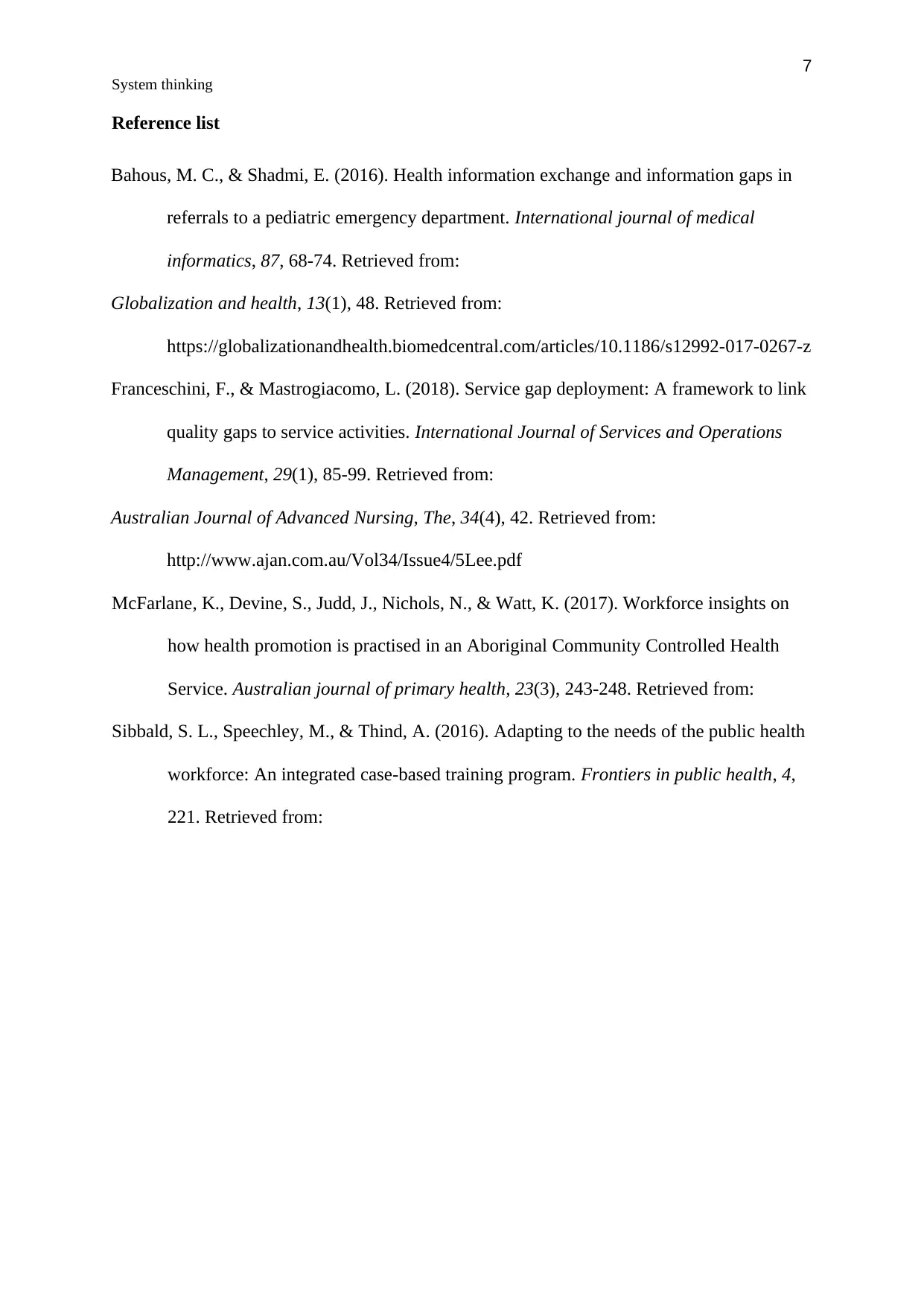
7
System thinking
Reference list
Bahous, M. C., & Shadmi, E. (2016). Health information exchange and information gaps in
referrals to a pediatric emergency department. International journal of medical
informatics, 87, 68-74. Retrieved from:
Globalization and health, 13(1), 48. Retrieved from:
https://globalizationandhealth.biomedcentral.com/articles/10.1186/s12992-017-0267-z
Franceschini, F., & Mastrogiacomo, L. (2018). Service gap deployment: A framework to link
quality gaps to service activities. International Journal of Services and Operations
Management, 29(1), 85-99. Retrieved from:
Australian Journal of Advanced Nursing, The, 34(4), 42. Retrieved from:
http://www.ajan.com.au/Vol34/Issue4/5Lee.pdf
McFarlane, K., Devine, S., Judd, J., Nichols, N., & Watt, K. (2017). Workforce insights on
how health promotion is practised in an Aboriginal Community Controlled Health
Service. Australian journal of primary health, 23(3), 243-248. Retrieved from:
Sibbald, S. L., Speechley, M., & Thind, A. (2016). Adapting to the needs of the public health
workforce: An integrated case-based training program. Frontiers in public health, 4,
221. Retrieved from:
System thinking
Reference list
Bahous, M. C., & Shadmi, E. (2016). Health information exchange and information gaps in
referrals to a pediatric emergency department. International journal of medical
informatics, 87, 68-74. Retrieved from:
Globalization and health, 13(1), 48. Retrieved from:
https://globalizationandhealth.biomedcentral.com/articles/10.1186/s12992-017-0267-z
Franceschini, F., & Mastrogiacomo, L. (2018). Service gap deployment: A framework to link
quality gaps to service activities. International Journal of Services and Operations
Management, 29(1), 85-99. Retrieved from:
Australian Journal of Advanced Nursing, The, 34(4), 42. Retrieved from:
http://www.ajan.com.au/Vol34/Issue4/5Lee.pdf
McFarlane, K., Devine, S., Judd, J., Nichols, N., & Watt, K. (2017). Workforce insights on
how health promotion is practised in an Aboriginal Community Controlled Health
Service. Australian journal of primary health, 23(3), 243-248. Retrieved from:
Sibbald, S. L., Speechley, M., & Thind, A. (2016). Adapting to the needs of the public health
workforce: An integrated case-based training program. Frontiers in public health, 4,
221. Retrieved from:
1 out of 7
Related Documents
Your All-in-One AI-Powered Toolkit for Academic Success.
+13062052269
info@desklib.com
Available 24*7 on WhatsApp / Email
![[object Object]](/_next/static/media/star-bottom.7253800d.svg)
Unlock your academic potential
Copyright © 2020–2025 A2Z Services. All Rights Reserved. Developed and managed by ZUCOL.





